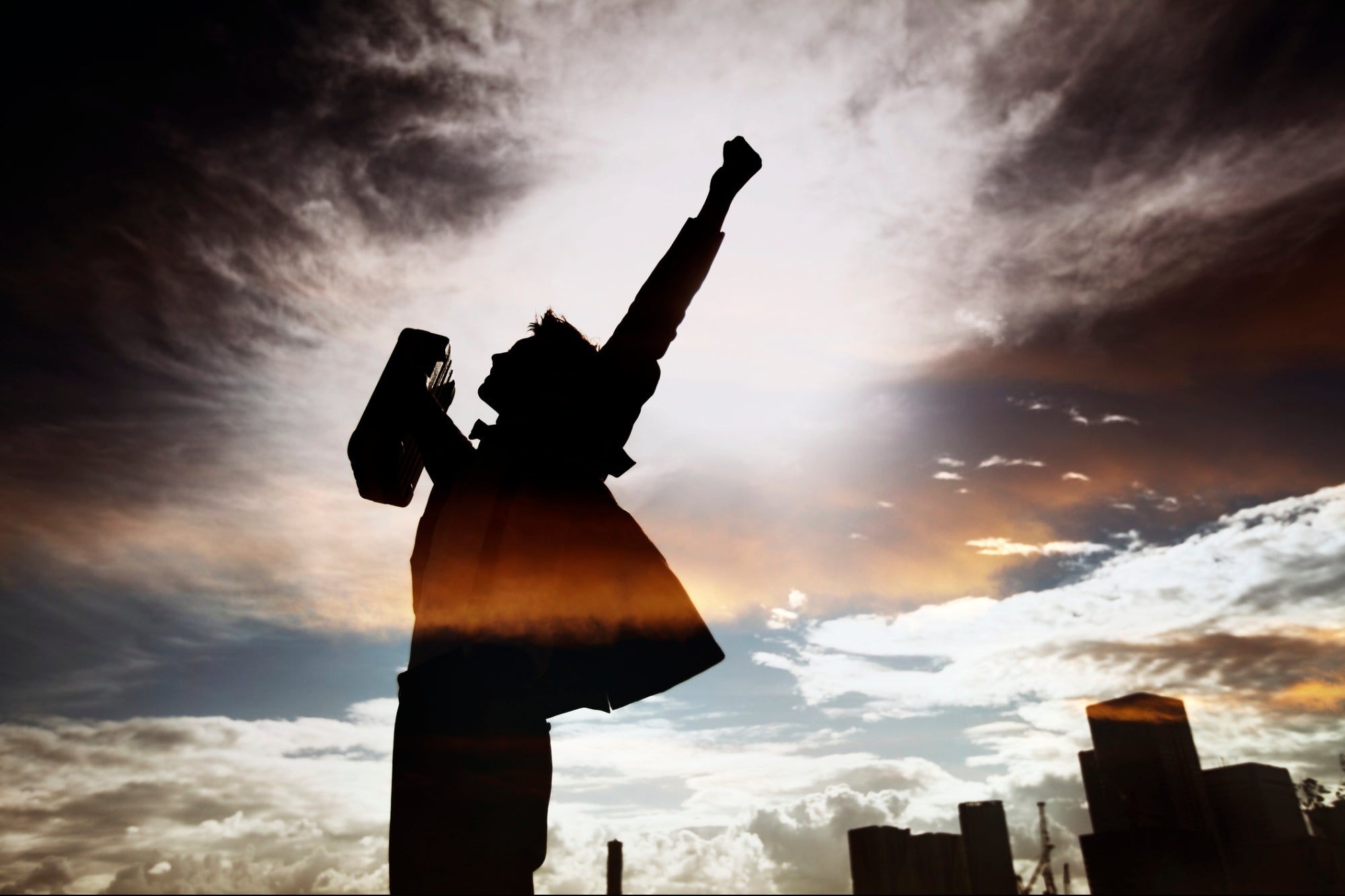
June
10, 2021
12 min read
Opinions expressed by Entrepreneur contributors are their own.
Do you remember the first job or career you ever dreamed about having when you were really young? I do. I was five or six years old and completely in love with horses, so naturally, I wanted to be a horse jockey. Yep, I wanted to fly down a track vying for first place while getting dirt flung in my face by the competition’s pounding hooves.
Okay, I didn’t actually dream about the dirt part — that realization came much later — but not before my dream was quickly shot down by my mother. It was well-intended, of course. After all, I was off the charts with my growth and my pediatrician predicted that I’d grow to be over 6 feet, far taller than the typical tiny horse jockey.
After my mother broke the sad news to me that I’d never be a horse jockey, I gave up on that dream and identified another. Naturally, I let my heart lead and picked another sport I loved: gymnastics. I got the same “Oh, you can’t do that” from my mother and for the same reason: too tall.
Now before you go thinking that my mother was a mean-spirited dream-killer, it wasn’t like that at all. She was being practical and “realistic.” She was taking what she observed to be true up to that point (that jockeys and gymnasts are very small) and was transposing it onto my dreams, all with the good intention of sparing me heartbreak when my ambitions hit the wall of the “real world”.
Beliefs can limit or multiply possibilities
But isn’t that the rub?
Being “practical” or restricting your ambitions to what others have already achieved limits your own possibilities, and, frankly, what might be possible for everyone else, too. Even more damaging is how limiting beliefs affect your personal well-being, world view and outer reality. What you believe to be possible or true directly impacts not only your emotional and mental states, but also directly impacts the actions you take or don’t.
Related: Neuroscience Tells Us How to Hack Our Brains for Success
A perfect example of limiting beliefs in action is when everyone “knew” that it was “impossible” to run a mile in under four minutes. For the longest time, no one could achieve a sub-four-minute mile. That is, until Roger Bannister did it on May 6, 1954. And then do you know what happened? Like magic, a lot of other people started recording sub-four-minute miles — and doing it even faster than Bannister.
So how was it that so many people had tried but no one had managed to beat the clock for so long? Because everyone (incorrectly) “knew” it was “impossible”. It was an accepted belief and scientific “fact” that the human body was incapable of such speed until the day that Bannister disproved all of it.
Humans’ brains are wired for safety and familiarity in all their forms: physical, mental and emotional. The need for safety and familiarity often shows up as risk avoidance, and failure is perceived to be one of the biggest risks. Therefore, if you buy into a collective belief that something is impossible to do or hold a belief that it’s impossible for you personally, then your brain will label it as extremely risky and call up all the reasons why failure is assured, even before you’ve started. You’ve got to believe something is possible and possible for you – or at least that there’s a chance it could be – to even attempt to achieve an outcome.
Beware of other people’s opinions
Sadly, we often accept others’ opinions and judgments about us as incontrovertible truth, especially when they come from our family or authority figures. As a result, we reduce ourselves, our ambitions and our abilities to perceive opportunities outside the invisible boundaries of limitation that we’ve accepted as true. Over time, our big, creative, outside-the-box thinking gets conditioned out of us. We subconsciously integrate these dream-killing experiences and messages, especially when they come disguised at what’s considered reasonable, practical or realistic.
Especially as children, we’re chided for dreaming big and wanting to take risks. We’re told that what we want is dangerous or it’s simply impossible. Then as adults, we’re so accustomed to hearing that our dreams are crazy, that our goals are impossible, or that our ideas are too radical that we default to doing what seems safe and realistic, squashing our own dreams, desires and ambitions under a deluge of “good reasons”. All of this limits who we are and what we’re capable of, to the detriment of all.
I’ve sometimes wondered what different life path I might have taken if instead of “You’ll be too tall” my mother had said, “I don’t think there’s ever been a jockey as tall as you before, but you could be the first”. Maybe I would’ve pursued a career riding astride thundering hooves, maybe not. As a parent myself, I now deeply understand the constant balancing act of supporting a child’s dreams and creative ambitions while wrestling with the urge to protect them from disappointment, unreasonable risk and harm. And yet we owe it to ourselves and others to not pre-suppose failure and cut the legs out from under the chance to try and succeed.
Related: 10 Reasons Why Failure Teaches Us More Than Success
Free yourself from limitation
As entrepreneurs, our success hinges upon our abilities to imagine beyond what’s already been achieved by ourselves and others — think Elon Musk — and to take advantage of opportunities that others can’t see or think is simply crazy – think Jeff Bezos when he started Amazon as an online book store. More importantly, the world needs more people thinking outside the box, challenging accepted beliefs and willing to take risks to solve the collective problems we face. What I know for sure — and which has been demonstrated time and time again — is that every one of us is far more limitless than we’ve been conditioned to believe or we tell ourselves. This message is picking up momentum and shifting things from the way we educate our children, to tech innovations, to how we approach tapping into our true human potential.
Thankfully, certain individuals seem to be wired to be disruptors or have trained themselves to have a possibilities-focused mindset, and they stand as thought leaders, innovators, and real-life examples for all of us to learn from. Once Bannister broke the time record and proved that running a sub-four-minute mile was indeed possible, other runners suddenly could do it, too, simply because the collective and individual beliefs had shifted overnight in light of Bannister’s accomplishment.
We must unlearn beliefs that keep our creativity strangled, rewire our brains to seek out possibilities, and dare to take risks, fail, and try again faster than ever before if we are to not only excel in our own lives but also overcome the huge social and planetary problems we currently face.
Related: How to Develop Mental Toughness to Power Through 2021 and Beyond
3 practices to unleash your limitless self
So how do you start to shed the beliefs holding you back and become limitless in a world that indoctrinates us with beliefs in limitation? Follow these three steps to get started:
1. Practice regularly second-guessing your beliefs and assumptions.
Just like your body, your mind needs regular maintenance to stay in top shape and serve you well. One of the sneakiest mindset traps that rob us of energy, opportunities and real-world results is hanging onto old beliefs and assumptions that end up clogging up our big, beautiful minds. They are often disguised as “facts”, “truths” or “just the way it is” and lead us to being far less than limitless, with less than stellar results to show for it.
Starting today, make a list of areas in your personal and professional lives where you’ve been holding yourself back, have settled into a comfortable routine or have been procrastinating about improving even though you know you’d benefit greatly from doing so. For example, many entrepreneurs sacrifice health and wellness practices in exchange for more hours working on their businesses. They falsely believe that doing so will yield better results, when ignoring or minimizing wellness practices actually leads to diminishing productivity, exhaustion and a lack of creative problem-solving capabilities.
Once you have your list, next to each entry write down what the specific challenge or limitation is, as you currently perceive it, and the associated beliefs and assumptions about the situation. Continuing with the example above, one belief may be that you don’t have enough time to exercise or meditate. An associated assumption may be that if you take time out of your workday to exercise, then you’ll lose business and earn less money. These beliefs may dictate that it’s a “fact” that you’ll lose business as a result. Write down as many beliefs and assumptions for each entry as you can.
Then ask yourself the magic questions…
- Is this really true?
- Is it true 100% of the time and in all situations for everyone?
- Can I prove it’s true beyond a shadow of a doubt?
If you answer “no” to any of these questions, then your belief isn’t “fact” and your assumptions are likely incorrect. You now have inserted doubt into your limiting belief or assumption, which is the first step to dismantling it and building a more empowering belief set.
2. Give yourself permission to think and act differently — and then do it!
Now that you’ve started to dismantle some of your limiting beliefs and assumptions, you’ve opened the door to thinking and acting differently and to reaping the benefits. The next step is to give yourself permission to think and act in ways that you haven’t before. This can be tough, especially if the belief set you’re dismantling is rooted in strong cultural, societal or religious conditioning, but it’s possible!
Using the example, you might discover that deep down that you believe that successful people are only successful if they work hard all the time. If you take time out of your day, then you may believe that you’re not working hard enough and you won’t be successful. Or you might believe that taking time for yourself to exercise is selfish because it takes time away from your family and business. Or that you only deserve time off when you’ve earned it, with “earning it” usually being some incredibly high bar to reach.
Again, list as many as you can think of and add to your list as more come to mind over the following days. Then use these prompts to start to shift your perspective, install more supportive beliefs and see possibilities that align with a truly limitless you:
- Which of these beliefs and assumptions supports my mental, physical and spiritual well-being and which do not?
- Which of these am I now willing to let go of or see differently?
- If I no longer believed this limiting thought, what would I like to believe instead?
3. Challenge yourself to dream bigger and bolder to push the boundaries of perceived limitation
Intentional dreaming sparks creativity and opens the door to new ideas and untapped possibilities. Now it’s time to think outside the box and let the ideas flow without judgment. Write down your answers to the following prompts:
- If you were to plug back into that inner dreamer and creative powerhouse part of yourself (often subdued when you were a child) and let your imagination run wild, what would you dream for yourself? For your loved ones? For your community and even beyond?
- If you were truly limitless and the possibilities infinite, what goals would you set for yourself? What would you try?
Now, looking at your list, if it were possible for you to achieve the “impossible”, what would be your top three? And, what would need to change within yourself and your life to support your success with those?
Being limitless isn’t about being perfect
Memory and brain training expert, Jim Kwik, says “Being limitless isn’t about being perfect, it’s about advancing and progressing beyond what you believe is possible”, and I couldn’t agree more.
When you regularly test your own limits and succeed, you gain in confidence and skill. And if you fail? Then you grow through the lessons learned and experience gained. Either way, you win if you adopt a mindset that failure is vital feedback needed to discover what you’re truly capable of. But you’ll never discover what’s truly possible for you if you don’t first question your current beliefs and give yourself permission to test the boundaries of who you think you can be.
Choose possibility over pragmatism and progress over perfection, time and time again. That is how you’ll become truly limitless.




